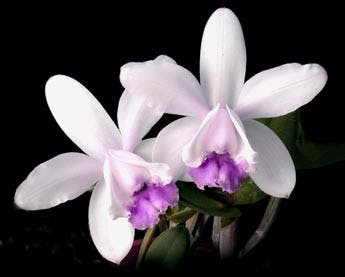
Cattleya intermedia (Orlata) 'Canaima's Tamara' AM/AOS 81pts; Exhib: Canaima Orchids
Cattleya intermedia is a coastal species whose range extends from Rio de Janeiro south to Brazil's border with Uruguay and into that country. Plants from Rio de Janeiro can be found growing on low scrub at Cabo Frio with some plants appearing to grow from the sandy beachheads. These plants are of a more dwarf nature probably due to the extreme conditions. With such a wide, or shall we say long, coastal distribution the species is adaptable to a variety of cultural conditions. Southern Brazil is more temperate than the rest of the country and plants from Rio Grande do Sul are quite tolerant of cooler conditions than many other bifoliate cattleyas (not implying C. intermedia to be a cool-growing species).
Another attractive characteristic of this cattleya is its compact growth habit. Plants are generally from 5-8" (13-20cm) tall while flowers can be up to 4" (10cm) or larger and borne 2-3 per inflorescence. While the specific epithet refers to the flower size as being intermediate between the Cattleya species known when it was introduced in 1824, flowers seen in today's collections are probably larger and of finer form than what was seen then due to line breeding of select cultivars.
But the main attraction of Cattleya intermedia is the variety of this single species. The typical flower is pale lavender-pink with a lip that has a rich fuchsia midlobe. Natural spread is on average about 3-½ (9cm) and flowers are generally quite flat. Petals and sepals can be narrow but choice examples have a fuller, rounder form. Some of the color forms seen in collections are orlata (round full lip opening with side lobes edged same color as midlobe), amethystina (nearly white flowers with soft pink midlobe), parthenia (pure white flowers), vinicolor (wine-red midlobe), coerulea (soft bluish flowers with slate-blue midlobe), and the peloric form aquinii (also known as flamea). There are also combinations of some of these color forms. The aquinii form is the foundation for much of the breeding of splash-petaled Cattleya hybrids.

Cattleya intermedia (Aquinii) also known as var. flamea
Last year we moved many of the C. intermedia into clay pots with large chunks of hardwood charcoal and a top dressing of a bark mix (fir bark, perlite, chunky peat and diatomite). This technique somewhat replicates mounting the orchids but lessens the watering needs and offers the display convenience of a pot. We sprinkle a tablespoon of 20-20-20 time-release fertilizer granules mixed with granular lime on a 5-6-inch pot. The plants look extremely healthy this year. Keep in mind though that we grow in an open shadehouse where summer rains can be frequent and heavy. If you grow orchids in a greenhouse you probably should lean more toward Miranda's suggestion of not letting the plants stay dry for too long and use straight bark or bark-based potting mix. Plants could probably be grown on cork or other mount but would need to be watered frequently if not constantly. The best time to repot C. intermedia is when there is a cluster of half-inch or less root tips at the base of the newest pseudoblubs. This usually occurs a month or so after flowering. Although some root activity can be present at any time during the year it is best to pot only when vigorous.
Like most orchids, given that other cultural factors are complimentary, better growth is possible at the high end of the light range, but C. intermedia can be grown anywhere from bright to shady bright. See our article on light here. Even if you use time-release fertilizer, it is beneficial to fertilize weekly during the growing season with a balanced liquid fertilizer applied at half-strength. C. intermedia will tolerate a wide range of temperatures and even extremes for short periods. Plants can tolerate temperatures in the 90º F range if given proper humidity and air movement and as low as 45º F for short periods if plants are kept dry. The optimal temperature range is 55-82º F.

Cattleya intermedia (Coerulea) 'Celeste' HCC/AOS
References
Withner, Carl. 1988. The Cattleyas and Their Relatives: Volume I, The Cattleyas. Timber Press, Portland.
Fowlie, Jack. 1977. The Brazilian Bifoliate Cattleyas and Their Color Varieties. Day Printing Corp, Pomona.
Miranda, Francisco. Brazilian Orchids website www.mirandaorchids.com
Greg Allikas, April 2010
1) Laelia purpurata









